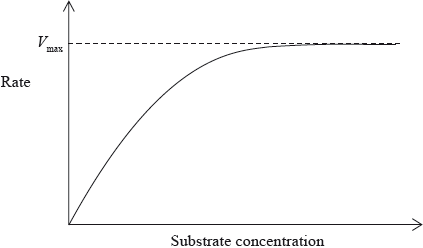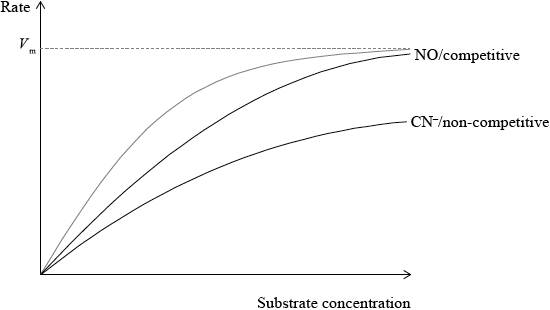| Date | November 2013 | Marks available | 2 | Reference code | 13N.3.hl.TZ0.9 |
| Level | HL | Paper | 3 | Time zone | TZ0 |
| Command term | Deduce | Question number | 9 | Adapted from | N/A |
Question
Enzymes are catalysts that increase the rate of all biochemical reactions, including those involved in respiration.
Cytochrome oxidase is a complex enzyme that catalyses the reduction of oxygen in the final stage of aerobic respiration. This enzyme is inhibited both by nitrogen(II) oxide, NO, and separately by cyanide ions, \({\text{C}}{{\text{N}}^ - }\). It has been suggested that NO acts competitively while \({\text{C}}{{\text{N}}^ - }\) acts non-competitively in inhibiting the enzyme. Experiments were carried out to test this hypothesis.
The graph below shows the effect of substrate concentration on the rate of the reaction in the absence of an inhibitor. Draw and label the results of the two experiments showing how the rate of the reaction changes in the presence of NO and in the presence of \({\text{C}}{{\text{N}}^ - }\), if the hypothesis is correct.

Suggest a reason why it is more likely that NO, rather than \({\text{C}}{{\text{N}}^ - }\), acts competitively.
The reducing agent in the cytochrome oxidase reaction is a species that can be denoted as \({\text{X}}{{\text{H}}_{\text{2}}}\) in the reduced form. Using this notation, deduce an equation for the reaction of \({\text{X}}{{\text{H}}_{\text{2}}}\) and \({{\text{O}}_{\text{2}}}\), and outline, using oxidation numbers, why it is a redox reaction.
Markscheme

line labelled NO/competitive reaching \({V_{\text{m}}}\) but with lower gradient;
line labelled \({\text{C}}{{\text{N}}^ - }\)/non-competitive not reaching \({V_{\text{m}}}\);
NO more likely to fit into active site / NO (structure) similar to \({{\text{O}}_2}\) / \({\text{C}}{{\text{N}}^ - }\) structure different to \({{\text{O}}_2}\) / OWTTE;
\({\text{2X}}{{\text{H}}_2} + {{\text{O}}_2} \to {\text{2X}} + {\text{2}}{{\text{H}}_2}{\text{O}}/{\text{X}}{{\text{H}}_2} + {{\text{O}}_2} \to {\text{X(OH}}{{\text{)}}_2}/{\text{X}}{{\text{H}}_{\text{2}}} + {{\text{O}}_{\text{2}}} \to {\text{XO}} + {{\text{H}}_{\text{2}}}{\text{O}}\);
oxygen changes from 0 to –2;
Allow X2 instead of 2X.
Do not allow 2– notation.
Accept “X changes from –2 to 0 in X or X2“ or “X changes from –2 to +2 in X(OH)2/XO”.
Examiners report
Option B was a very popular, and question 6 was well answered with the exception of not listing alkenyl when identifying two functional groups common to three vitamins (A, C and D). Some students did not read the question on formula of zwitterion carefully and instead have the formula of the amino acid itself without any charges. In the separation of alanine and cysteine, the first mark was well scored by many while the second mark proved to be more demanding and often candidates lost this mark as no reference was made to charges or charges inversely stated. Although the disulfide bridge was correctly identified by even weaker candidates a much few were able to identify this as a covalent bond. Structure of the triglyceride was better answered than in past sessions but drawing the ester linkage correctly was still challenging for many candidates. Although the identification of the other reactant (water) was identified by many, the one essential condition (enzyme/lipase) was done poorly. Identification of the polyunsaturated fatty acid was done well by most but the second mark on its ability to lower LDL cholesterol was missed by most. The question on enzymes and inorganic catalysts was done poorly since comparison was often missing. While some candidates were able to suggest a pair of ions in cytochrome oxidase, only stronger candidates provided both pairs. Competitive and non-competitive inhibition was generally well done; however, the reason why it is more likely that NO, rather than the cyanide ion, acts competitively was not done as well. The redox reaction of the reducing agent \({\text{X}}{{\text{H}}_{\text{2}}}\) with \({{\text{O}}_{\text{2}}}\) produced a range of possible equations but rarely did candidates scored full marks.
Option B was a very popular, and question 6 was well answered with the exception of not listing alkenyl when identifying two functional groups common to three vitamins (A, C and D). Some students did not read the question on formula of zwitterion carefully and instead have the formula of the amino acid itself without any charges. In the separation of alanine and cysteine, the first mark was well scored by many while the second mark proved to be more demanding and often candidates lost this mark as no reference was made to charges or charges inversely stated. Although the disulfide bridge was correctly identified by even weaker candidates a much few were able to identify this as a covalent bond. Structure of the triglyceride was better answered than in past sessions but drawing the ester linkage correctly was still challenging for many candidates. Although the identification of the other reactant (water) was identified by many, the one essential condition (enzyme/lipase) was done poorly. Identification of the polyunsaturated fatty acid was done well by most but the second mark on its ability to lower LDL cholesterol was missed by most. The question on enzymes and inorganic catalysts was done poorly since comparison was often missing. While some candidates were able to suggest a pair of ions in cytochrome oxidase, only stronger candidates provided both pairs. Competitive and non-competitive inhibition was generally well done; however, the reason why it is more likely that NO, rather than the cyanide ion, acts competitively was not done as well. The redox reaction of the reducing agent \({\text{X}}{{\text{H}}_{\text{2}}}\) with \({{\text{O}}_{\text{2}}}\) produced a range of possible equations but rarely did candidates scored full marks.
Option B was a very popular, and question 6 was well answered with the exception of not listing alkenyl when identifying two functional groups common to three vitamins (A, C and D). Some students did not read the question on formula of zwitterion carefully and instead have the formula of the amino acid itself without any charges. In the separation of alanine and cysteine, the first mark was well scored by many while the second mark proved to be more demanding and often candidates lost this mark as no reference was made to charges or charges inversely stated. Although the disulfide bridge was correctly identified by even weaker candidates a much few were able to identify this as a covalent bond. Structure of the triglyceride was better answered than in past sessions but drawing the ester linkage correctly was still challenging for many candidates. Although the identification of the other reactant (water) was identified by many, the one essential condition (enzyme/lipase) was done poorly. Identification of the polyunsaturated fatty acid was done well by most but the second mark on its ability to lower LDL cholesterol was missed by most. The question on enzymes and inorganic catalysts was done poorly since comparison was often missing. While some candidates were able to suggest a pair of ions in cytochrome oxidase, only stronger candidates provided both pairs. Competitive and non-competitive inhibition was generally well done; however, the reason why it is more likely that NO, rather than the cyanide ion, acts competitively was not done as well. The redox reaction of the reducing agent \({\text{X}}{{\text{H}}_{\text{2}}}\) with \({{\text{O}}_{\text{2}}}\) produced a range of possible equations but rarely did candidates scored full marks.

